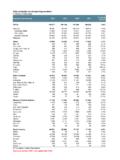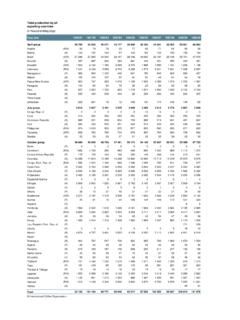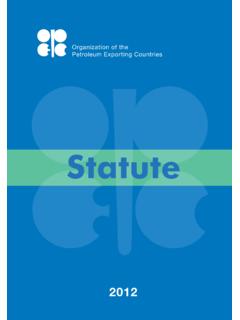Transcription of MEAT Market situation - Food and Agriculture …
1 3. COMMODITY SNAPSHOTSOECD-FAO AGRICULTURAL OUTLOOK 2016-2025 OECD/FAO 2016107 MEATM arket situationWeaker demand for meats by emerging economies and oil exporting countriesthroughout 2015 exerted significant downward pressure on meat prices. According to theFAO Meat Price Index, meat prices in 2015 fell to a level last seen in early 2010. This fallcontrasts with an extended period of continued, though at times volatile, meat priceincreases that started back in 2002. Only once during this extended period during theaftermath of the 2007-08 financial crisis have meat prices fallen by such a trade in 2015 stalled in volume terms. Meat exports from the Americas, thedominant supplier region, fell in 2015 reflecting weakening supply to the rest of the imports from the Russian Federation, and a net trade loss in North Americaestimated at close to one million tonnes, substantially reduced supplies going to otherparts of the highlightsTheOutlookfor the meat Market remains strong.
2 Feed grain prices are set to remainlow for the projection period, giving stability to a sector that had been operating in anenvironment of particularly high and volatile feed costs over most of the past decade. Thisis particularly relevant for regions such as the Americas, Australia and Europe, where feedgrains are being used more intensively in the production of meat production is projected to be 16% higher in 2025 than in the base period(2013-15). This compares with an increase of almost 20% in the previous countries are projected to account for the vast majority of the total increase,through a more intensive use of protein meal in feed rations. Poultry meat is the primarydriver of the growth in total meat production in response to expanding global demand forthis more affordable animal protein compared to red meats. Low production costs andlower product prices have contributed to making poultry the meat of choice both forproducers and consumers in developing countries .
3 In the bovine meat sector, several yearsof cow herd liquidation in major producing regions resulted in low beef production in , production is expected to grow from 2016 onwards, with higher carcass weightsmore than offsetting the decline in cattle slaughter. Pigmeat production will also growafter 2016, driven by China, where herd size is expected to stabilise after years ofsubstantial reductions (a drop of 25 million pigs between 2012 and 2015). Another factorcontributing to China s output expansion in the coming years is further consolidation ofthe pork sector. Production is also expected to increase in the sheepmeat sector with anexpected global growth of , a higher rate than the last decade, and led by China,Pakistan, Sudan and 10% of meat output will be traded in 2025, up from 9% in 2015, with most ofthe increase coming from poultry meat. Import demand will be weak during the first yearsof the outlook period, mainly due to lower imports due to the import ban ofthe Russian Federation and slower growth in China, but will strengthen in the second halfof the projection period, due to import growth in the developing world.
4 The mostsignificant growth in import demand originates from Viet Nam, which captures a large3. COMMODITY SNAPSHOTSOECD-FAO AGRICULTURAL OUTLOOK 2016-2025 OECD/FAO 2016108share of additional imports for all meat types. Africa is another fast growing meatimporting region albeit from a lower base. Although developed countries are still expectedto account for slightly more than half of global meat exports by 2025, their share is steadilydecreasing relative to the base period. On the other hand, Brazil s share of global exports isexpected to increase to around 26%, contributing to nearly half of the expected increase inglobal meat exports over the projection meat prices are expected to start at levels similar to those registered in 2010,and in most cases, trend marginally upwards. By 2025, prices for beef and pigmeat areprojected to increase to around USD 4 497/t carcass weight equivalent ( ) andUSD 1 580/t respectively, while world sheepmeat and poultry prices are expected torise to around USD 3 857/t and USD 1 571/t product weight ( ) respectively.
5 In realterms meat prices are expected to trend down from their recent high levels (Figure ).Global annual meat consumption per capita is expected to reach kg retail weightequivalent ( ) by 2025, an increase of kg compared to the base period. Thisadditional consumption will consist mainly of poultry. In absolute terms, totalconsumption growth in developed countries over the projection period is expected toremain small relative to developing regions, where rapid population growth andurbanisation remains the core drivers. This is particularly true in Sub-Saharan Africa,where the rate of total consumption growth over the outlook period is faster than any otherregion. The composition of growth is also somewhat unique, with the absolute growth inbeef almost matching , animal disease outbreaks and trade policies remain among the main factorsdriving the evolution and dynamics in world meat implementation of varioustrade agreements, such as the proposed Trans-Pacific Partnership, over the outlook periodcould increase and diversify meat trade.
6 An announcement in 2015 by InternationalAgency for Research on Cancer of the World Health Organization (IARC) classifiedFigure meat pricesNote:US Choice steers, 1 100-1 300 lb dressed weight, Nebraska. New Zealand lamb schedule price dressed weight, all grade average. USBarrows and gilts, No. 1-3, 230-250 lb dressed weight, Iowa/South Minnesota. Brazil: Export unit value for chicken (FOB) product :OECD/FAO (2016), OECD-FAO Agricultural Outlook ,OECD Agriculture statistics(database), 2 0002 0003 0004 0005 0006 000 5001 0001 5002 0002 5001995200020052010201520202025199520002 0052010201520202025199520002005201020152 02020251995200020052010201520202025 PorkPoultryBeef (right axis)Sheep (right axis)USD/tUSD/tNominal priceReal price3. COMMODITY SNAPSHOTSOECD-FAO AGRICULTURAL OUTLOOK 2016-2025 OECD/FAO 2016109processed meat2as carcinogenic. This raised concerns among consumers worldwide andmay impact the projected consumption of countries with high per capita expanded meat chapter is available 1 OECD-FAO AGRICULTURAL OUTLOOK 2016 OECD/FAO 2016 MEAT Prices Meat prices fell in 2015 from recent record levels, in both nominal and real terms.
7 During the projection period, prices will in general increase slightly in nominal terms due to slow economic growth, and trend moderately downwards in real terms, though the actual path will differ depending on the type of meat. Nominal bovine meat prices will decline until 2020 in line with an expansion of output in key producing areas of the world. In the period that follows, however, increases in feed costs will slow down production growth, putting upward pressure on beef prices. Nominal pigmeat prices will slightly increase from their current levels, and therefore somewhat decline in real terms. Notable features of the global sector that shape this trend are increased supply from North America, the People s Republic of China (hereafter China ) and Brazil, and lower imports from the Russian Federation. In poultry, low production costs and cross price effects through strong substitutability among the various meats induce nominal poultry prices to increase slightly, along with feed prices, while prices in real terms remain stable throughout the projection.
8 Nominal sheepmeat prices are expected to remain low due partly to weaker import demand from China and the Middle East, combined with increasingly high lamb production in Australia. In New Zealand, the continued expansion of the dairy herd is not expected to allow sheep numbers to grow over the outlook period, though it should be noted that many sheep farms in New Zealand are mixed, running both sheep and beef cattle as the two species complement each other in managing pasture and price risks. Over the next decade, production will benefit somewhat from better feed conversion rations and somewhat from positive meat-to-feed price margins as well as better feed conversion ratios. Increased productivity will also lead to a positive supply response and lower meat prices for the projection period. Poultry meat remains the primary driver of the growth in total meat production, mainly in response to expanding global demand in the developing world.
9 Low production costs, high feed conversion ratios, and low product prices have contributed to making poultry the meat of choice, both for producers and consumers. 2 MEAT OECD-FAO AGRICULTURAL OUTLOOK 2016 OECD/FAO 2016 Figure Feed cost index and meat to feed price ratios Source: OECD/FAO (2016), OECD-FAO Agricultural Outlook , OECD Agriculture statistics (database), 12 Production Livestock supply responses to Market signals continue to be influenced by environmental and food safety regulations, in addition to the availability of natural resources, and technical and technological opportunities for productivity gains. As such, there is potential for production growth in many developing countries where natural grasslands and agricultural land abound for producing feed grains, South America or in Sub-Saharan Africa. Figure Growth of meat production by region and meat type 2025 vs 2013-15 Note: is carcass weight equivalent, is ready to cook equivalent.
10 Source: OECD/FAO (2016), OECD-FAO Agricultural Outlook , OECD Agriculture statistics (database), 12 Cost Index (left)Pig meat/Feed Index (right)Poulty/Feed Index (right)Beef/Feed Index (right)2003-05=12003-05= 0 10 20 30 40 50 60 BeefPorkPoultrySheepBeefPorkPoultrySheep Total increaseDevelopingDevelopedMt ( or )MEAT 3 OECD-FAO AGRICULTURAL OUTLOOK 2016 OECD/FAO 2016 Total meat production is projected to expand to around 48 Mt by 2025, predominantly in developing countries which will account for approximately 73% of the additional output (Figure ). Meat production in developing countries continues to be dominated by Brazil and China, the largest meat producers and where output is expected to expand considerably over the outlook period. Brazil s production growth will benefit from an abundant supply of natural resources, feed and grassland availability, productivity gains, and the real devaluation.

















